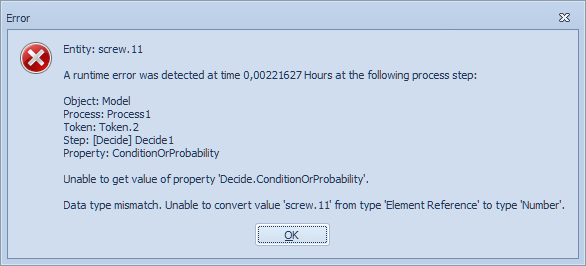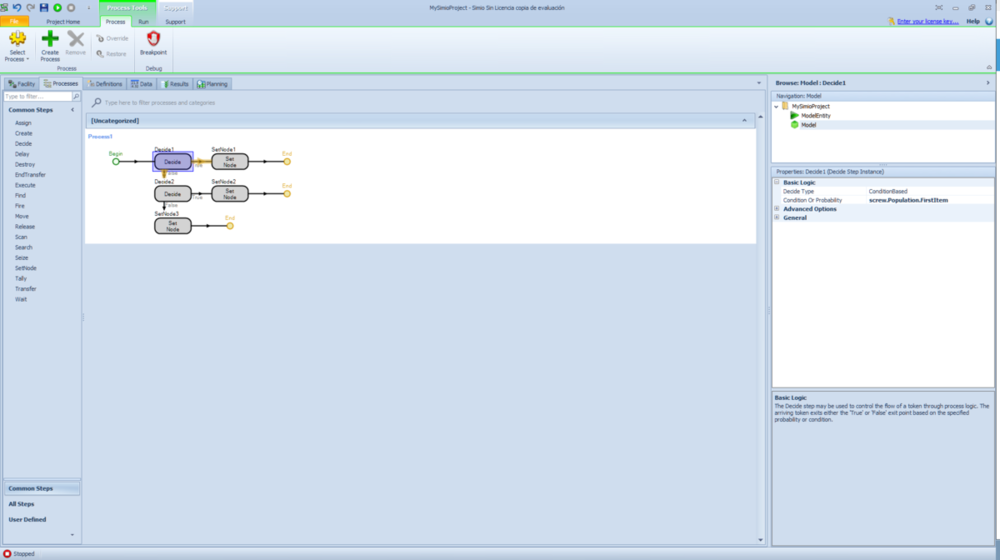Search the Community
Showing results for 'buffer transfer node'.
-
Sequence Table - Destination as 'Node list property'
mohmed Shaikh replied to mohmed Shaikh's topic in SI General Discussions
Many thanks CWatson. This worked. I was able to use 'Select from List' from the transfer node. -
Crane Library - Bridge and Underhung bridge cranes
Rylan Carney replied to dsturrock's topic in SI Shared Items
Hello ttarken, A simplified approach might be use a Resource to constrain the system until the required operator is available. If the operator should move with the Crane, a good starting point might be to try seizing a Worker and requesting a move to the pickup Node. Then, you could try using a Move step to move the Worker from the pickup Node to the drop-off Node with the Crane. Please see below a link to a similar post discussing how to use two Cranes to move a single entity. The example model attached to the other post might provide guidance for your application. -
Modeling multiple cranes on a common (shared) runway is hard to do well. Still harder when you take into account acceleration, crane blocking, and good 3D animation. If you have encountered this problem, here is a solution. For standard bridge crane movement, we recommend the simpler Crane object in the Extras library. But if you need the underhung cranes with cabs moving between bays, read on... The Simio Crane Library is a collection of objects designed for modeling multiple cranes operating simultaneously in a bay. The library is provided as an example of complex material handling using the standard features of Simio. The Crane library may be used in conjunction with the Simio Standard Library, and Crane pickups are done using the standard TransferNode (e.g. the output side of a Server). Crane drop-offs can be done at either a BasicNode or TransferNode. The Crane Library can also be used with custom libraries as long as they support rider pickups using the standard transporter ride features. The Crane Library consists of objects representing the Bay, Bridge, Cab, Lift, and Crane (the end effecter that actually picks up and drops off the item). These objects are combined together to model multiple cranes moving in a single bay. The separation of objects in this way allows you to use your own symbol for each component. A Crane movement occurs by first rising up from the pickup node to a specified travel height, traveling laterally at that height, and then lowering down to the specified drop-off node. All travel is done through free space without the need to explicitly draw a network. The Crane library also fully supports independent acceleration/deceleration and the ability for one crane to cause another blocking crane to move out of the way. The above library file is now obsolete. Instead, download the library posted closest to the bottom topics. Like all Simio-provided libraries, this library is open so you can look at how it was built, learn from it, and subclass your own objects to improve them. But unlike our built-in libraries, this is not fully supported (although we can provide some help) and we may not continue enhancing it, particularly if we decide to build this capability into the base Simio products. We are anxious to receive your feedback on this library.
-
This is a very simple question that is common to many models. Let's imagine I just want an element where entities will be stored untill some other element 'pulls' from them. What is the easiest way to imlement having rich information on the amount of entities stored in that element, their average throughput time, etc? Many thanks.
-
In my model a truck (vehicle) is delivering packages (ModelEntities) to customers (Sink) following the road (Paths). Now I want to model a drone (vehicle) that brings packages (ModelEntities) to the truck (vehicle) using free space. Challenges: - The drone and truck can only exchange packages when the truck is not moving. (He's at a customer location) How can i find the next stop of the truck and thus the destination that the drone needs to go to. - How do i best transfer packages from the drone onto the truck. Knowing that the truck goes from sink to sink and at these locations there is no buffer available.
-
Hello, I specified a simple sequence of destinations for an entity with a sequence table and I would like to change the symbol of a subclass server depending on the current node destination of this sequence. I tried to make a process with a decide step but I can not find the good expression to get the current node destination. I am new with Simio so I wonder if it is a good way to proceed or if there is a better one? Best regards,
-
First Entity Id created should be Entity.1
simiouser1 replied to simiouser1's topic in SI General Discussions
Maybe my application is easier. I would like to create a batch of 150 entities, but only the first and the last should go to a different server than other 148. To do that, I have created a transfer node and I created a procces with to decide node, asking if the entity is the first or the last. But it does not work. -
Sebastian, I don't know if this is what you need, but maybe if you change the paths to connectors and set the 4th server input buffer to 0 it might work. rds. block_test1.spfx
- 2 replies
-
- 1
-

-
- blocked server
- queueing
-
(and 1 more)
Tagged with:
-
Multiple Entity with multiple sequence tables
USP2010 replied to JanainaF's topic in SI General Discussions
To Whom It May Concern, I also have a very similar issue with multiple entities and multiple paths (for some entities). Could I also have the solution shared in this forum? I have tried multiple sources, transfer nodes, and sequence tables. I just seem to be running into different errors trying to achieve the same goal. Thank you, in advance, for your assistance! -
Hi I want my simulation to start with some entities at the output node of a server. Is that possible? Thanks in advance Janus
-
Node depending Crane's Load/Unload Time
gocken replied to MauricioBiolato's topic in SI General Discussions
Subclass a transfer node then define two properties: LoadTime and UnloadTime. Then use these subclassed nodes in your model and set the values of LoadTime and UnloadTime properties appropriately for each subclassed transfer nodes. Also, define two properties on modelentity: you can name them as LoadTime and UnloadTime. Then, define an entered add-on process for each subclassed transfer nodes where you should assign ModelEntity.LoadTime=LoadTime and ModelEntity.UnloadTime=UnloadTime. Now, by setting loadtime and unloadtime properties of crane object as ModelEntity.UnloadTime and ModelEntity.LoadTime you can get different times for load and unload times at different points. -
Sample model that uses dwell time at a node from a schedule
ASagan posted a topic in SI Shared Items
The attached model relates to the discussion at the following post: http://www.simio.com/forums/viewtopic.php?f=1&t=1165 I created a very basic, not quite fully functional, 'dwell time' model that calculates the dwell time based on how soon the next departure slot is according to Dave's example above. I don't feel this approach is very elegant but it can help others get started. sampleDwellTimeModel.spfx -
1) The model seems working as you intended. The animation seems the logic is not working but in fact the animation is delayed (in the animation the modelentity is at output node of server2 i.e., seems behind the scheule but if you examine trace window the modelentity is just at combiner memberinput buffer.) 2) I think the process logics are not required if you will not use them for further modeling purposes. I mean If you set appropriate parent match expression and member match expression at combiner1 object, the object itself will combine them automatically (it will perform all the operations you performed in your processes). Try not to use them?
-
Hi I am currently working on modeling a facility whose description I provide below and attach its simio file to this message: 1)There are Two entities each titled 'Small Package' and 'Large Package' that enter the system through a Server titled 'Shooter' 2) Four worker elements take the incoming packages to 16 Sinks titled as 'Carts' 3) I have set up a process at the Output@Server1 so that each worker element serves a specific set of Carts Worker 1 -> Cart1, Cart2, Cart 3, Cart 4 Worker 2 -> Cart 5, Cart 6, Cart 7, Cart 8 Worker 3 -> Cart 9, Cart 10, Cart 11, Cart 12 Worker 4 -> Cart 13, Cart 14, Cart 15, Cart 16 4) I have used paths elements to keep track of worker distance covered over the period of time I run the simulation 5) I have also placed 8 Transfer Nodes whose locations will be clear on viewing the attached file. My questions are as follows: Q.1) Say worker 1 collects his first package and goes to place it on to cart 4, can worker 1 than collect the next package for say cart2 from the transfer node close to cart 2? Essentially I would like the workers to move as less as possible because in reality they just pick packages from in front of the respective carts. Is there a smart way to do this keeping my process logic for Output@Server1 intact? Q.2) Currently I have my experiments monitor Utilization of workers, their Idle time and distance covered. I would love to hear from experts here as to what other Responses might be good yard sticks that can help better understand the efficiency of the system or its bottle necks? Thanks, Best Regards, 16sinks_edit3.spfx
- 4 replies
-
- worker
- distance covered
-
(and 1 more)
Tagged with:
-
Re-Evaluating the Request Queue of a Node
agraunke replied to MEagar's topic in SI General Discussions
From the project view, select "Copy from library to edit" and choose the transfer node. Copying from the library breaks inheritance (so you are no longer working with a subclass of a TransferNode), and because of that you can change the definitions of that object. Subclassing only allows one to extend definitions or override processes. My understanding is that this is good object-oriented design, rather than a bug The downside is that since you've copied the object, rather than subclassed it, your new object will no longer be updated as a TransferNode (in future sprints). You will essentially have a brand new object definition and it is up to you to maintain the definition. -Adam -
Hello. I'm quite new to make process logic in Simio. I have 3 Servers(server1, server2, server3) and the entity travel from server1 to server2 and server3 in order by Vehicle1. The server2 and server3 do not have any buffer; zero input buffer and zero output buffer. So, I need a process which controls deadlock. I thought when the destination of Vehicle1 is Output@Server1, check whether server2 has an entity in processing buffer. If it has, again, check server3 has an entity in processing buffer. So, my conditions are below when the destination of Vehicle1 is Output@Server1. 1. If Server2 and Server3 have an entity in processing buffer, wait until Server3 has finished process, then transfer entity in server3 to Sink1 first and transfer entity in Server2 to Server3. 2. If Only Server2 has an entity, wait unitl Server2 has finished process, then transfer entity in Server2 to Server3 and transfer entity in Server1 to Server2. 3. If Only Server3 has an entity, do not wait any situation. I've built a process steps to implement it, but doesn't work.. I don't know my logic has problems or process step has problems... I've attached my model below. Could you solve or suggest about my problem? Thank you. Jay. RoutingProblem.spfx
-
Hi, I made a simple warehouse-retailer model with a source(warehouse), two servers(retailers), and a sink, where the entities(products) are carried from the source to the servers using a single vehicle. The current capacities(demand value at the retailer) of the servers changes after a specific time interval(12-hours and simulation run time of100 days). The Input and Output buffer capacities of both the servers are set to zero. The vehicle leaving the source (Home node) returns back only after serving the respective current capacities of the servers one after the other. As each entity enters the server, its capacity is reduced by 1 unit ultimately reaching zero-current capacity when the full capacity is served. The problem I encounter is that sometimes after my vehicle leaves the source, the current capacity value of the server changes and the new value might be smaller than the previous current capacity value. So my vehicle stays at the input node of the server with the extra entities carried until a new current capacity value is assigned, instead of moving to the next server with whatever entities are left in the vehicle. I don't intend to change the vehicle speed or time interval for capacity changes to rectify this issue. For example, the current capacity values of the servers at time period 1 are Server 1 = 10 & Server 2 = 12. So the vehicle carries 10+12=22 entities from the source to the server 1. Now while the vehicle is moving towards Server 1, if the current capacity changes to Server 1 = 8 & Server 2 = 12, the vehicle stays at server 1 after serving the 8 units and the remaining 14 units stays within the vehicle instead of moving to the next server to serve its capacity. Screenshot of the model is attached. Could anyone help me with this issue? I would really appreciate your support as I have been trying to fix this issue for a while.
-
You need to search the queue when the server goes off shift (Search Block_Queue), and Transfer the Students back to the Decision making node (Transfer Block -> Make Sure its the last block in the process). That is the easiest fix, other than setting the input buffers to zero.
- 1 reply
-
- 1
-

-
Greetings! I have this problem and I'm probably doing something wrong. I'm trying to use the Find Step to make my entities look for the closest server through the DirectDistanceTo Expression. This Process is triggered when the entity enters a Transfer Node. Based on these screenshots, can you tell me what am I doing wrong? I'm almost certain the Search Expression is incorrect. Thanks!
-
Ever have a rectangular box moving short edge first on one conveyor and then connect at a 90 degree angle to another conveyor on which you want it to ride long edge first. This rather flexible object will do that in any orientation. And has a few extra options as well. Part of the "trick" is to have two pictures of the same object oriented off by 90 degrees. Use this as is or as a basis for your own customized object. (Requires sprint 68 or later) Someday this may involve into a SimBit with a full explanation, but in the interim, enjoy. TransferDeviceSimBit.zip
-
Combine several entities in to one entity
gocken replied to BTECHStudent's topic in SI General Discussions
It seems the best way to achieve to what u want is to define three storage elements (called barstorage, gridstorage, sheetstorage) just before the combiner object or combiner node. Whenever an entity is put into any of these storages check the the condition u defined (i.e., exactly 4 bars, 4 grids and 8 sheets are exist in the individiual storage) is valid. If the condition is satisfied remove appropriate number entities (exactly 4 bars, 4 grids and 8 sheets) from appropriate storage by using search and remove step and transfer them to combiner object from standard library (or even combiner node object you get from forum) to combine them all. Else wait for the condition to be met. By this way you are able to collect some extra statistics from storages (averge waiting times and average number of each materials in the storage etc...). -
Hi All,
I am repeatedly getting this (attached picture) error in my Simio Model, what could be the probable cause and what should I make sure so that this problem does not repeat?
I have added transfer, end transfer step in my process logic.
I also have made sure I have enough storage capacity and also enough vehicles to complete the transfer.
any suggestions would be helpful.
Thank you

-
As far as I understand I included my solution approach. You may wonder that the included logic does not seem work (it will always increases the capacity but wont decrease it). This may be due to your servers processing time or on/off shift schedules. I mean that in order to see how it works you should increase capacity by some predeterimed number (i.e., 10. Currently it is set to 1) and decrease it one each time any entity enters or departs waitingarea1 node. you may also increase run time to further see what happens. I hope this one meets your requirements. Still it will inspire you. NOTE: You should note that the unit time conversions and your problems' values. The logic triggers capacity increments or decrements each time an entity enters or departs from waitingarea1. Note also that waiting times are calculated as averages of those who wait at waitingarea1 transfer node throughout the simulation run. pharmacy_candidate solution.spfx
-
Is there a way to keep them in the loop until the transport arrives, there will never be a point where they are done with the loop until the transport gets there. Right now if they are in the loop I can assign them a modelentity state variable (boolean), then when a vehicle arrives it initiates a process that has a search step with the search condition modelentity.BooleanStateVariable==1 with a return limit of the capacity of the vehicle. the found entities must either interrupt the task or process they are currently doing depending on where they are in the loop and be moved by a worker to the evac node. If that seams like a plausible solution, I just need a process step that can completely cancel a task sequence because the interrupt and suspend steps do not seem to apply to tasks. Once the task sequence is suspended the modelentities should flow to the destination node no problem after leaving the server.






